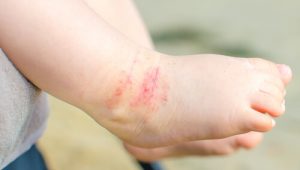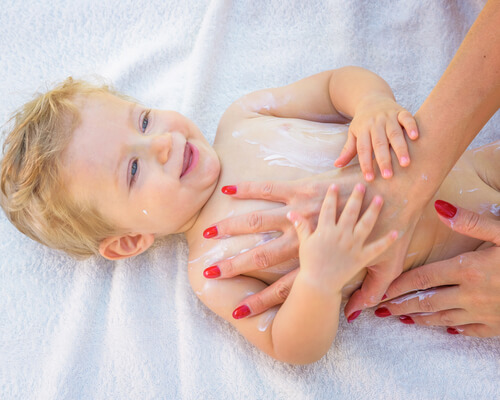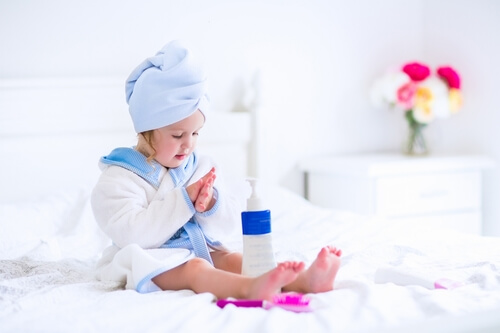15 Tips for Dealing with Atopic Dermatitis in Children

It’s particularly important for parents to know how to deal with common skin problems like atopic dermatitis in children.
Our skin is the largest organ in our bodies, and is often the one that receives the least attention.
But pollution, temperature changes and solar radiation can all damage skin, particularly when there is an underlying skin condition.
A common condition
Atopic dermatitis is an inflammatory illness that has become increasingly common in the last few years. Children make up 90% of all cases, and 20% of children under six suffer from this condition.
Atopic dermatitis is one of the most frequent reasons for parents to visit a dermatologist. It generally appears at around five years of age.
Some people with the condition will have it for the rest of their life, while others will get over it as they grow older. It’s very rare for atopic dermatitis to appear for the first time in an adult.
Children may begin to show symptoms between two and three months of age. The condition is characterized by rashes that lead to extremely dry, itchy, red skin.
Outbreaks appear most frequently on the scalp, cheeks, knees and elbows.

How to care for atopic dermatitis in children
Atopic dermatitis currently has no cure, but it’s possible to avoid outbreaks. To do this, follow the advice below.
- Identifying the factors that lead to outbreaks is the first step to dealing with atopic dermatitis in children. Each outbreak increases the likelihood of a relapse. Since this condition is related to the body’s immune response, it’s important to avoid possible allergens, such as animal fur/dander, dust mites, pollen, dust and others.
- Cleanse, hydrate and protect the skin using gentle products especially designed for this type of skin. Avoid harsh soap, fragrance and alcohol.
- After cleansing, pat the skin dry instead of rubbing. Use soft towels that won’t damage your child’s skin.
- Avoid synthetic fibers and wool, both of which can cause allergic reactions. Cotton clothes are best for children with atopic dermatitis.
- When you wash your child’s clothes, use an extra rinse cycle to get rid of any remaining laundry detergent. Avoid fabric softeners.
- Follow your doctor’s advice on treatments. Don’t stop a treatment regime if you see the symptoms start to go away, as this can lead to a relapse.
- Use products to moisturize your child’s skin at least twice a day. These can include creams, lotions, oils, among others. Moisturizers give skin back its elasticity and protect against irritation and itching.

- Make sure to use lukewarm water to bathe your child. Avoid hot water, which can worsen dry skin.
- It’s very important to keep the child’s nails short. This way, if they scratch themselves, they won’t do too much damage.
- Long baths aren’t good for children with atopic dermatitis. Baths should last no longer than 10 minutes. Children with this condition should avoid taking more than one bath or shower a day. In fact, a daily bath might not even be necessary, and bathing every other day is often better for this condition. This will depend on the time of year and weather conditions.
- Try to keep their environment fairly cool and humid. Ventilate your home daily and avoid turning the heating up to a high temperature in winter.
- Avoid wrapping your child up in too many warm clothes. Sweating can worsen an outbreak of atopic dermatitis.
- Use sunscreen every day.
- If your child isn’t taking allergy medicine that could make them more sensitive, a little sun can be good for damaged skin. Avoid exposure around midday when the sun is strongest, however.
- Educate your child about their condition. Help them care for their own skin. This will be key to minimizing outbreaks.
By following this advice for dealing with atopic dermatitis in children, you’ll be able to reduce the number and severity of outbreaks, helping your child cope with this common skin condition.
It’s particularly important for parents to know how to deal with common skin problems like atopic dermatitis in children.
Our skin is the largest organ in our bodies, and is often the one that receives the least attention.
But pollution, temperature changes and solar radiation can all damage skin, particularly when there is an underlying skin condition.
A common condition
Atopic dermatitis is an inflammatory illness that has become increasingly common in the last few years. Children make up 90% of all cases, and 20% of children under six suffer from this condition.
Atopic dermatitis is one of the most frequent reasons for parents to visit a dermatologist. It generally appears at around five years of age.
Some people with the condition will have it for the rest of their life, while others will get over it as they grow older. It’s very rare for atopic dermatitis to appear for the first time in an adult.
Children may begin to show symptoms between two and three months of age. The condition is characterized by rashes that lead to extremely dry, itchy, red skin.
Outbreaks appear most frequently on the scalp, cheeks, knees and elbows.

How to care for atopic dermatitis in children
Atopic dermatitis currently has no cure, but it’s possible to avoid outbreaks. To do this, follow the advice below.
- Identifying the factors that lead to outbreaks is the first step to dealing with atopic dermatitis in children. Each outbreak increases the likelihood of a relapse. Since this condition is related to the body’s immune response, it’s important to avoid possible allergens, such as animal fur/dander, dust mites, pollen, dust and others.
- Cleanse, hydrate and protect the skin using gentle products especially designed for this type of skin. Avoid harsh soap, fragrance and alcohol.
- After cleansing, pat the skin dry instead of rubbing. Use soft towels that won’t damage your child’s skin.
- Avoid synthetic fibers and wool, both of which can cause allergic reactions. Cotton clothes are best for children with atopic dermatitis.
- When you wash your child’s clothes, use an extra rinse cycle to get rid of any remaining laundry detergent. Avoid fabric softeners.
- Follow your doctor’s advice on treatments. Don’t stop a treatment regime if you see the symptoms start to go away, as this can lead to a relapse.
- Use products to moisturize your child’s skin at least twice a day. These can include creams, lotions, oils, among others. Moisturizers give skin back its elasticity and protect against irritation and itching.

- Make sure to use lukewarm water to bathe your child. Avoid hot water, which can worsen dry skin.
- It’s very important to keep the child’s nails short. This way, if they scratch themselves, they won’t do too much damage.
- Long baths aren’t good for children with atopic dermatitis. Baths should last no longer than 10 minutes. Children with this condition should avoid taking more than one bath or shower a day. In fact, a daily bath might not even be necessary, and bathing every other day is often better for this condition. This will depend on the time of year and weather conditions.
- Try to keep their environment fairly cool and humid. Ventilate your home daily and avoid turning the heating up to a high temperature in winter.
- Avoid wrapping your child up in too many warm clothes. Sweating can worsen an outbreak of atopic dermatitis.
- Use sunscreen every day.
- If your child isn’t taking allergy medicine that could make them more sensitive, a little sun can be good for damaged skin. Avoid exposure around midday when the sun is strongest, however.
- Educate your child about their condition. Help them care for their own skin. This will be key to minimizing outbreaks.
By following this advice for dealing with atopic dermatitis in children, you’ll be able to reduce the number and severity of outbreaks, helping your child cope with this common skin condition.
This text is provided for informational purposes only and does not replace consultation with a professional. If in doubt, consult your specialist.








